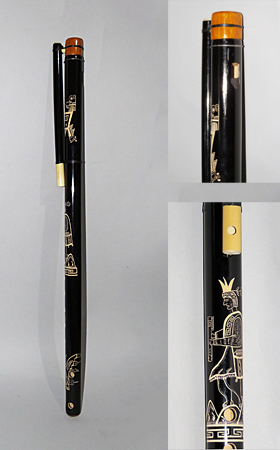
Owner: HWMC
Catalog#: 2CL-AEWF-5
Flutes
Tabor Pipe: 'Fujara'
Slovakia
Folk: Slovakian Shepherds
Wood, pigment, fiber
Late 1900s
Length: 29.75 in
Wind Instruments – Woodwind Instruments – Flutes – Whistle
The fujara is a wind instrument of the tabor pipe classification. It originated in central Slovakia as a folk shepherd’s overtone fipple flute. This small fujara has six finger holes located on the lower main body. It is painted with a black varnish pigment and has ornate incised carvings of people and geometric designs. The air is blown threw a hole in a smaller parallel pipe called vzduchovod in Slovak (meaning “air channel”). The vzduchovod is mounted to the main body, where the air is led to the fipple, splitting the air.
The larger fujaras may ranging from 5’3” to 6’6” with three finger holes, requiring the player to blow overtones to play a diatonic scale. However, the diatonic scale can be fingered on this smaller version and the pitch range is much higher.
The larger fujara is typically played while standing and held vertical, while this smaller fugara is often held horizonal. Traditionally, the fujara was played by shepherds for recreation and for signaling. Today, it has moved to the stage of folk festivals in the Slovak towns of Východná and Detva.
The fujara was added to the UNESCO list of Masterpieces of the Oral and Intangible Heritage of Humanity in 2005. “The Fujara and its Music” was added to the Representative List of the Intangible Cultural Heritage of Humanity in 2008 by UNESCO.
Resource: Fujara – Wikipedia
